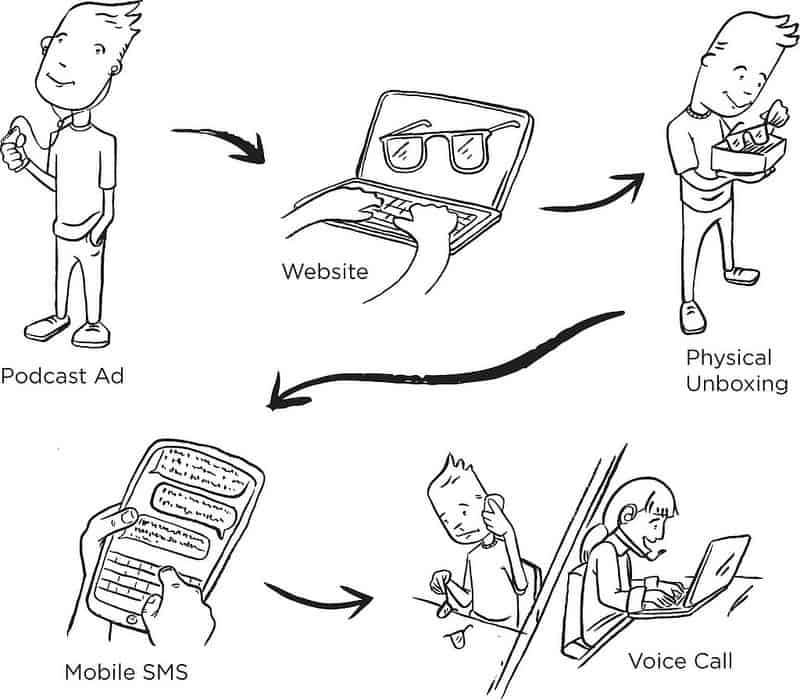Orchestrating Experiences: Collaborative Design for Complexity
By Chris Risdon and Patrick Quattlebaum.
Foreword by Marc Rettig
Paperback: 336 pages
Published May 2018, Rosenfeld Media Books
ISBN: 1-933820-73-X
Digital ISBN: 1-933820-74-8
Customer experiences are increasingly complicated, with multiple channels, touchpoints, contexts, and moving parts, all delivered by fragmented organisations. How can you bring your ideas to life in the face of such complexity? Orchestrating Experiences is a practical guide for designers and everyone struggling to create products and services in complex environments.
What is this book about?
Good designers must thrive in tackling complicated challenges; it is becoming increasingly complex to define and target products and services. This, and a greater focus on creating unique or differentiated experiences, provides us with an opportunity to be a uniting voice for cross-functional teams. To create better experiences, however, means taking on challenges. We must reconsider how we understand customer journeys; reassess our choices in tools, processes and methods; and find ways to work as cross functional groups. Orchestrating Experiences defines this reassessment as:
- Moving towards a holistic view of complicated journeys that unfold over time, across channels, platforms, locations and people;
- We all have processes, methods, and frameworks for which we rely on understanding and solving design problems. But as we expand the lens through which we look at the customer experience, we’re realising we need to be agnostic of different design disciplines to deftly evaluate our design challenges and determine the best approaches
- Re-thinking how we organise ourselves, unifying disparate parts of the organisation. Silos need to be lowered and cross-functional groups united with our own response to the everlasting question: ‘How do we define a shared process for tackling these new challenges together, and reach across the organisation?’
A quick look at the contents provides a clear indication Orchestrating Experiences was written by Chris and Patrick to genuinely impact practices in a way that matters and which lasts:
Part I: A Common Foundation
Looks at the key concepts involved in understanding how experiences can be designed.
Chapter 1: Understanding Channels
Chapter 2: Pinning Down Touchpoints
Chapter 3: Exploring Ecosystems
Chapter 4: Orienting Around Journeys
Part II: Insights and Possibilities
A practical outline of how teams can adopt a customer-centric view, and how they can identify opportunities for improving experiences.
Chapter 5: Mapping Experiences
Chapter 6: Defining Experience Principles
Chapter 7: Identifying Opportunities
Part III: Vision and Action
Techniques and advice for collaboratively generating ideas and crafting visions that unite and inspire action.
Chapter 8: Generating and Evaluating Ideas
Chapter 9: Crafting a Tangible Vision
Chapter 10: Designing the Moment
Chapter 11: Taking Up the Baton

Who are the authors?
 Chris Risdon (Twitter @chrisrisdon) is currently director of design for peer-to-peer carsharing service Getaround, but was previously head of design for Capital One Labs. He’s an alumni of the pioneering experience design consultancy Adaptive Path where, as design director he introduced and advanced new methods in design. Chris holds an MFA in design from the Savannah College of Art and Design and is an adjunct professor at the California College of the Arts, teaching interaction design and service design to the next generation of designers.
Chris Risdon (Twitter @chrisrisdon) is currently director of design for peer-to-peer carsharing service Getaround, but was previously head of design for Capital One Labs. He’s an alumni of the pioneering experience design consultancy Adaptive Path where, as design director he introduced and advanced new methods in design. Chris holds an MFA in design from the Savannah College of Art and Design and is an adjunct professor at the California College of the Arts, teaching interaction design and service design to the next generation of designers.
 Patrick Quattlebaum (Twitter: @ptquattlebaum) is a designer, management consultant, and founder at studioPQ. He helps organisations experiment with and adopt collaborative approaches to designing service experiences and the operations that support them. He too hearkens from Adaptive Path, where he was managing director, before moving to become head of service design at Capital One when they acquired the consultancy. He is also a passionate design instructor, having taught thousands of practitioners in North America and Europe. He holds an MS in Information Design and Technology from the Georgia Institute of Technology. You can follow him on Twitter and @studiopq. Designer, consultant, & teacher.
Patrick Quattlebaum (Twitter: @ptquattlebaum) is a designer, management consultant, and founder at studioPQ. He helps organisations experiment with and adopt collaborative approaches to designing service experiences and the operations that support them. He too hearkens from Adaptive Path, where he was managing director, before moving to become head of service design at Capital One when they acquired the consultancy. He is also a passionate design instructor, having taught thousands of practitioners in North America and Europe. He holds an MS in Information Design and Technology from the Georgia Institute of Technology. You can follow him on Twitter and @studiopq. Designer, consultant, & teacher.

Who is this book for?
You’ll likely find this book on the shelf beside design books, but it is relevant to anyone involved in defining and creating products or services. In particular, if you’re working in environments with many channels, touchpoints and contexts, and as part of fragmented, siloed organisations attempting to deliver them, this book will equip you and your team to design better experiences together.
It does focus on cross-functional and collaborative teams, and argues strongly for why these are necessary when dealing with complex environments.
The book is pitched at three types of readers:
- Product and service practitioners of all stripes – people involved in defining strategies for customer experiences, designing or delivering them, or managing the activities involved.
- Lead roles and aspiring team members wanting to create impactful experiences at scale
- Executives and managers seeking customer-centred experiences as part of leaner operations
It includes fresh approaches for expanding your toolkit and designing collaboratively. It presents language and models to help teams engage, and concepts with high aims in fostering cross-functional collaboration, building empathy with customers and more effectively taking advantage of customer journeys.
How to make the most of ‘Orchestrating Experiences’
In the foreword, Marc Rettig describes a typical reader’s aspiration: ‘You are buying the book because you’re excited by what it describes, and you aspire to implement these practices’.
He’s right. That is why we buy books. But I know that the application of knowledge in the books I read is never as easy as simply understanding what needs to be done. Marc acknowledges this, and arms us with tools to make better use of what we learn in this one — patience, persistence, and “a habit of celebrating small steps”. He also gives us two bits of sage advice:
- Find a collaborator or two for this epic voyage. Don’t try it alone.
- Don’t launch straight into one of the workshops. Use Chapter 11. Use it all year as the brief for applying the rest of the book.
When you first pick up Orchestrating Experiences, there’s no way to predict the particular way it will take root in your work. As Marc says, ‘You have to live through the process of change to find out’.
What do others think?
“You’ll blow past your competition, as you shift from shipping discrete functionality to seamless end-to-end experiences.”
—Jared Spool, Maker of Awesomeness and Co-CEO of Center Centre/UIE
“By including workshop plans throughout Orchestrating Experiences, Patrick and Chris give the reader a way to make complex ideas immediately actionable.”
—Jon Kolko, Partner, Modernist Studio
“Hands down the best hands-on guide for service design. Love the in-the-trenches advice and step-by-step detail.”
—Jess McMullin, Principal, Situ Strategy
“Every interaction the customer has around your brand contributes to the story of their experience. This book provides actionable advice to tell a powerful story your customers will love.”
—Katie Dill, Vice President of Design, Lyft
Buy Orchestrating Experiences from Rosenfeld Media.
UX Mastery received a free review copy of this book from Rosenfeld Media but does not receive any commissions from sales. Please support one of our industry’s best publishers by purchasing directly from the Rosenfeld website.





